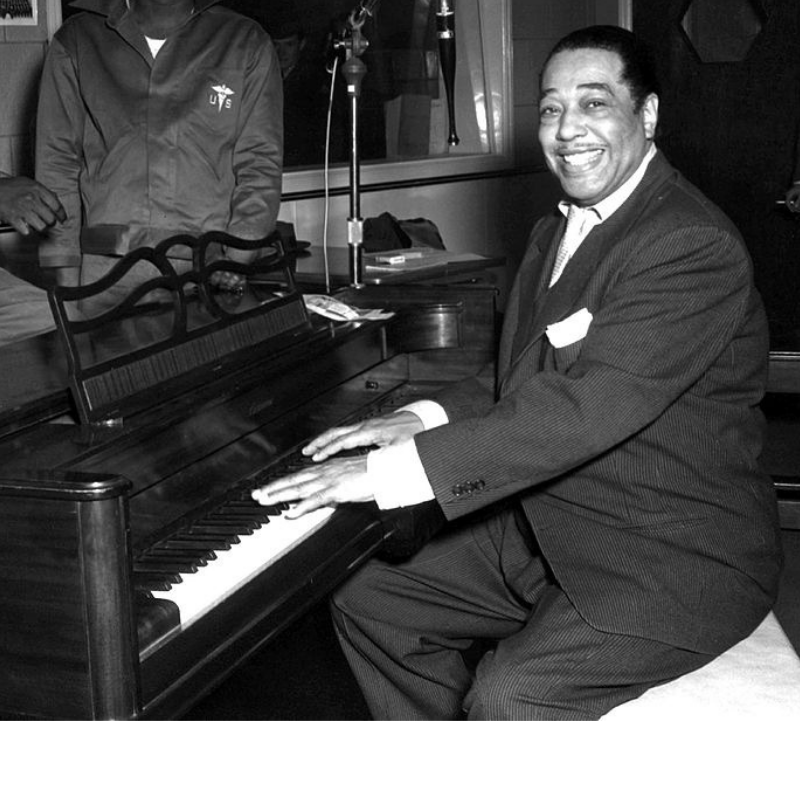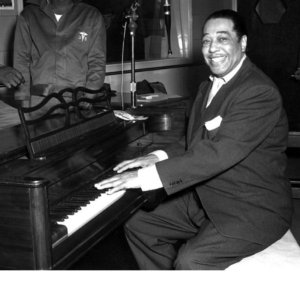The Beginner’s Guide To Duke Ellington
by
Ron Drotos
Have you heard much of Duke Ellington’s music yet? If this is your intro to his music, you’re in for a big treat! For my part, it’s very exciting to lead you on this music tour of Ellingtonia and I’d actually like to spend a few weeks together, listening to his music 24/7. (“Let’s check out Such Sweet Thunder!” “Oh, if you liked “Black and Tan Fantasy,” you’ll love “Creole Love Call!”)
Duke Ellington’s career began in the early days of jazz (1920s), and continued into the modern era of the 1970s. In fact, he kept his band together for so long, 50 years, that long-living rock groups like The Rolling Stones point to Ellington as a role model in this regard.
Edward “Duke” Ellington was born in Washington, DC, on April 29, 1899, which is right around the time that jazz was “born” as well. He wrote about the vibrant jazz scene of his formative years in his excellent autobiography Music Is My Mistress. (Fun fact: Ellington’s childhood piano teacher’s name was Mrs. Clinkscales!) Duke also recounts how he was influenced by the orchestral music that accompanied silent movies.
I’m going to resist the temptation to share the hundreds of Ellington recordings I love with you here. If you enjoy the six recordings I’ll discuss with you here, I hope you’ll view them as an invitation to explore musical gems such as Black, Brown and Beige, Masterpieces By Ellington, Afro Bossa, and The River.
Duke Ellington formed his first groups while still living in Washington, DC. But the real action began after he moved to New York City (although it took some time for him to become established there.) The big break came when Ellington and his orchestra began playing at The Cotton Club. Most importantly for their fame, they began broadcasting these performances on the radio to a large at-home audience.
Our musical tour of Ellington’s music begins with “Black And Tan Fantasy,” from 1928. One of Ellington’s musical contributions at this time was the use of both down-home, so-called “primitive” music and refined, “sophisticated” sounds in the same piece of music. 1927s “Black and Tan Fantasy” begins with the expressive plunger-mute trumpet playing of Bubber Miley, who gave the Ellington band a direct connection with the New Orleans roots of jazz. The tune’s ‘B’ section provides a contrast by taking us to the mellow sounds of the New York ballroom dance scene. (This was the original “Smooth Jazz!”)
Black and Tan Fantasy
https://www.youtube.com/watch?v=7ju_UTLAeuM
During the early decades of Ellington’s career, there was a big crossover between jazz and popular music. A jazz tune could become a pop hit and vice versa. Duke got his first taste of pop music success in 1931 with “Mood Indigo,” which features a horn arrangement that was very unusual for the era. Listen to how Ellington gave the trumpet, trombone, and clarinet their own melodic lines, all happening at the same time but with the same rhythm. This early example of “linear harmony” proved to be extremely influential in the development of jazz. Musicians such as Gil Evans, Herbie Hancock, and Keith Jarrett continued to explore this concept, decades later.
Mood Indigo
https://www.youtube.com/watch?v=y4ZFv742qdk
In addition to writing and playing swing-based jazz, Duke incorporated “exotic” Latin rhythms into his music during his entire career. Perhaps the most famous example of this is “Caravan,” composed by trombonist Juan Tizol. Here’s a rendition from 1952.
Caravan
In 1938, Billy Strayhorn met Ellington and soon began doing musical arrangements and composing for the group, most notably their theme song, “Take The ‘A’ Train.” Strayhorn gradually became Ellington’s true musical partner, composing much of the group’s repertoire over the years. Here’s the original recording of the “Take The ’A’Train”: Ellington’s piano intro is one of the most iconic moments in all of jazz!
Take The ‘A’ Train
In addition to composing short pieces of music, Ellington was interested in longer forms as well. In 1943, he premiered his extended composition “Black, Brown, and Beige” at Carnegie Hall. The most famous part of this piece is “Come Sunday,” which features his long-time alto saxophone player Johnny Hodges “singing” the lyrical melody over a hymn-like trombone harmonization. Later, in the 1960s, Ellington would further nurture his interest in composing religious music with his three Sacred Concerts.
Come Sunday
In addition to being a composer, arranger, and bandleader, Duke was an accomplished and innovative pianist. Like his composing, his piano stylings ranged from the bold and experimental to the tender and lyrical. Here’s his beautiful piece “Reflections in D,” which remains a favorite of many other jazz pianists. (There’s a beautiful recording by Bill Evans.)
Reflections In D
Duke Ellington’s career lasted for almost five decades, until his death in 1974. All through this time, he managed to stay fresh and enthusiastic in all his musical activities. This is evident in his late-period masterpiece “Ad Lib On Nippon,” from The Far East Suite. Although he and his band had traveled a great deal of geographic and music territory during their long career, all of the exciting musical elements from their early days are still evident in this lively and mature performance.
Ad Lib On Nippon
I hope you’ve enjoyed this introduction into the vast universe that is Duke Ellington and his music. In many ways, Ellington’s career parallels the development of jazz. He was there almost at the beginning, and lived long enough to record with the likes of Dizzy Gillespie, Charles Mingus, and John Coltrane. He maintained an active interest in learning about all types of music, and he even composed a few rock and roll tunes.
I love Ellington’s music, and I always feel re-invigorated after listening to him. I once spent an unforgettable evening rehearsing in his former residence on Riverside Avenue in Manhattan.
Good luck with your music, and let Duke Ellington be a never-ending source of musical inspiration for you.
Enjoy the journey, and “let the music flow!”
Ron
To learn more:
Duke Ellington: Wikipedia
Duke Ellington: Music Is My Mistress
Ellington wrote his autobiography himself, without a professional “ghostwriter,” and his charm, wit, and insatiable curiosity comes across on every page. He paints an especially vivid depiction of the early days of jazz and gives us a taste of what it was like to be a jazz musician in 1920s New York City.
The avant-garde side of Duke Ellington
The surprising similarity between Duke Ellington, Keith Jarrett, and Elton John
On a Turquoise Cloud with Duke Ellington
Duke Ellington’s favorite song
Cottontail (from The Jazz Pianist’s Ultimate Guide To The Real Book)
Learn the 5 Essential Left Hand Techniques with my free ebook: Left Hand Techniques for Jazz Piano
You’ll also get my weekly jazz newsletter with practice tips and inspiration


